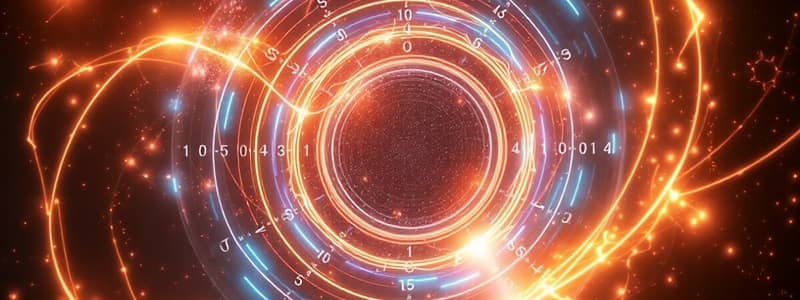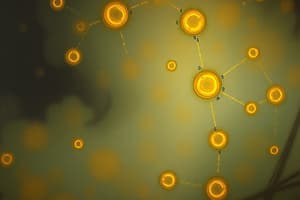Podcast
Questions and Answers
What is the primary focus of Chapter 19 in the Physical Science Practice Test?
What is the primary focus of Chapter 19 in the Physical Science Practice Test?
- Kinematic equations and motion
- Concepts related to physical sciences (correct)
- Chemical reactions and their classifications
- Principles of thermodynamics
Which concept is least likely to be discussed in a chapter focused on physical science?
Which concept is least likely to be discussed in a chapter focused on physical science?
- The structure of DNA (correct)
- The behavior of gases under pressure
- Newton's laws of motion
- Thermal conductivity of materials
What type of problem-solving technique might be emphasized in physical science contexts?
What type of problem-solving technique might be emphasized in physical science contexts?
- Graphical data interpretation (correct)
- Critical historical assessment
- Philosophical reasoning
- Literary analysis
In the study of physical science, which of the following is most relevant to understanding force and motion?
In the study of physical science, which of the following is most relevant to understanding force and motion?
Which of the following statements is true regarding the content typically found in a physical science chapter?
Which of the following statements is true regarding the content typically found in a physical science chapter?
Flashcards
Physical Science Practice Test Chapter 19 2014 B
Physical Science Practice Test Chapter 19 2014 B
A test covering the material from Chapter 19 of a physical science textbook, administered in 2014.
Content Library
Content Library
A collection of resources or materials used in a learning environment.
Using the Content Library Page
Using the Content Library Page
Pages within a document or book.
Page 1
Page 1
Signup and view all the flashcards
Page 6
Page 6
Signup and view all the flashcards
Study Notes
Physical Science Practice Test Chapter 19 2014
-
Ion Formulas and Charges: A table lists common ions, their formulas, and charges. Examples include: Ammonium (NH₄⁺), Hydronium (H₃O⁺), Acetate (C₂H₃O₂⁻), Carbonate (CO₃⁻²), Hydrogen Carbonate (HCO₃⁻), Hydroxide (OH⁻), Nitrate (NO₃⁻), Phosphate (PO₄⁻³). Peroxide (O₂⁻²), Sulfite (SO₃⁻²), Sulfate (SO₄⁻²), and Chromate (CrO₄⁻²).
-
Prefixes for Units of Measurement: A table shows the prefixes for various units of measurement. Examples: exa (10¹⁸), peta (10¹⁵), tera (10¹²), giga (10⁹), mega (10⁶), kilo (10³), hecto (10²), deka (10¹), deci (10⁻¹), centi (10⁻²), milli (10⁻³), micro (10⁻⁶), etc.
Criteria 19.1
- Maximum Electrons in Outer Shell: Elements like Magnesium or Bromine have a maximum number of electrons they can have in their outer shell.
- Atoms and Full Outer Shells: Atoms strive to have a full outer shell (true).
- Molecule Formation: Molecules are formed when atoms join together.
- Lewis Structure for Oxygen: The correct Lewis structure for oxygen is :Ö:.
- Diatomic Elements: Certain elements occur naturally as diatomic molecules. Examples (listed in the doc) include oxygen (O₂).
Criteria 19.2
- Ionic Compounds: A molecule shown is an ionic compound (true or false, from the text).
- Sodium Atom and Full Shell: Sodium's next inmost shell is already full (true or false, from the text).
- Covalent Bonds: Covalent bonds involve electron-sharing between elements (true or false, from the text).
- Valence Electrons in Krypton: Krypton has a specific number of valence electrons.
- Valence Electrons in Strontium: Strontium has a specific number of valence electrons.
- Valence Electrons in Lithium: Lithium has a specific number of valence electrons.
- Electronegativity: Electronegativity measures the attraction an element has for its electrons (true or false, from the text).
- Negative Ions and Electrons: Negative ions have more electrons than protons (true or false, from the text).
- Oxidation Number for Oxygen: The oxidation number for Oxygen.
- Oxidation Number for Iodine: The oxidation number for Iodine.
Criteria 19.3
- Standard Element for Mass Measurement: A specific element is used to measure the masses of all other elements.
- Molecules in a Mole: A mole of any compound contains a specific number of molecules.
- Mass of Ca(C₂H₃O₂)₂: The mass of calcium acetate (a compound), given a certain amount of moles.
- Mass of Uranium: The mass of one mole of uranium.
- Mass of Zn(NO₃)₂: The mass of zinc nitrate (a compound), given a certain amount of moles
Additional Information (Criteria X)
- Conversions: Converting between different units of measurement (millimeters to meters, kilograms to gigagrams, kilometers per hour to meters per second).
- Hydrated Compound: A hydrated compound has water within its structure.
- Mass of CaCO₃: Calculating the mass of calcium carbonate (a compound), given a specific amount of moles.
- Number of Molecules in Water: Calculating the number of water molecules given a volume of water.
Studying That Suits You
Use AI to generate personalized quizzes and flashcards to suit your learning preferences.




